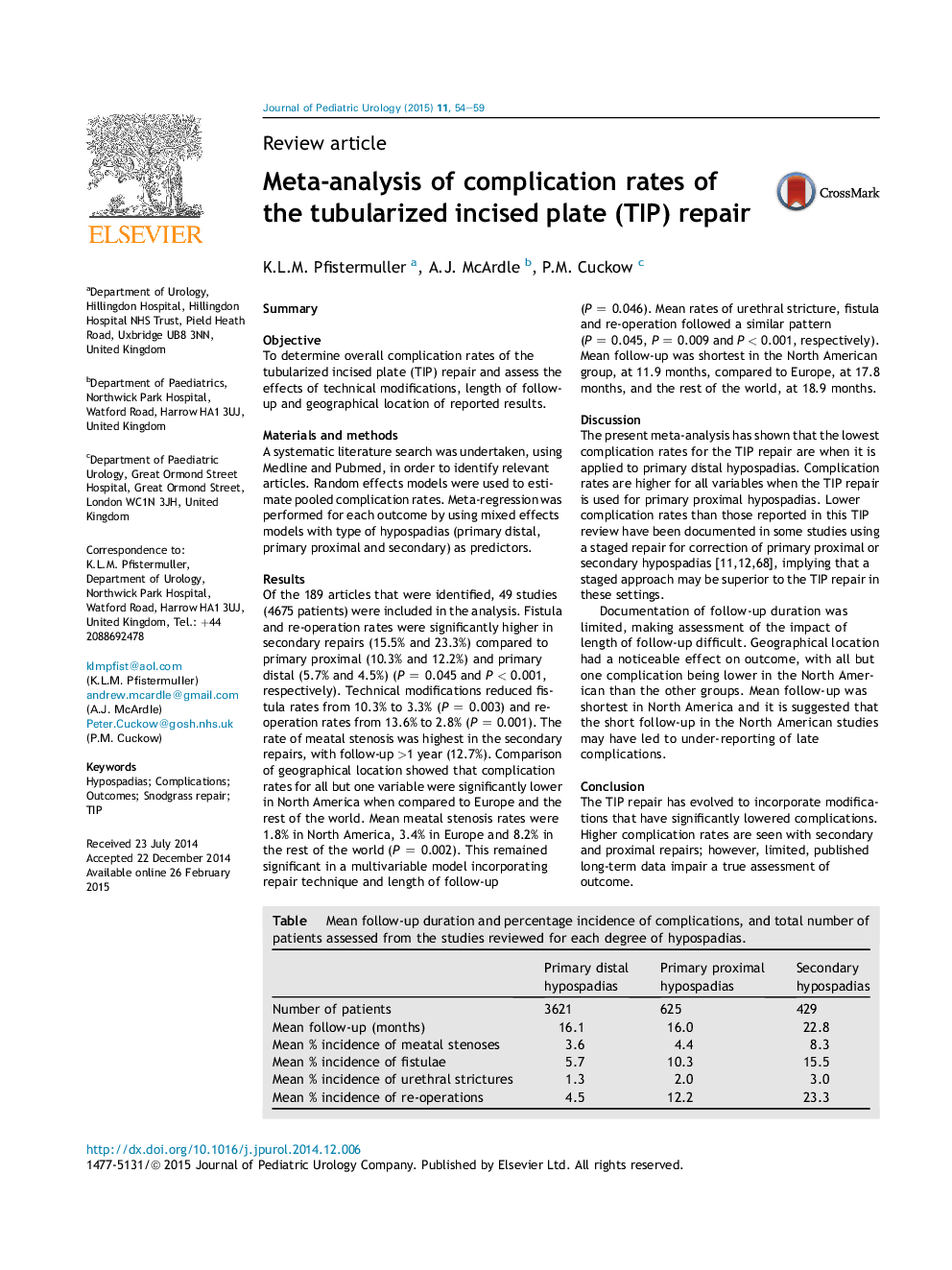| کد مقاله | کد نشریه | سال انتشار | مقاله انگلیسی | نسخه تمام متن |
|---|---|---|---|---|
| 4162245 | 1274275 | 2015 | 6 صفحه PDF | دانلود رایگان |

SummaryObjectiveTo determine overall complication rates of the tubularized incised plate (TIP) repair and assess the effects of technical modifications, length of follow-up and geographical location of reported results.Materials and methodsA systematic literature search was undertaken, using Medline and Pubmed, in order to identify relevant articles. Random effects models were used to estimate pooled complication rates. Meta-regression was performed for each outcome by using mixed effects models with type of hypospadias (primary distal, primary proximal and secondary) as predictors.ResultsOf the 189 articles that were identified, 49 studies (4675 patients) were included in the analysis. Fistula and re-operation rates were significantly higher in secondary repairs (15.5% and 23.3%) compared to primary proximal (10.3% and 12.2%) and primary distal (5.7% and 4.5%) (P = 0.045 and P < 0.001, respectively). Technical modifications reduced fistula rates from 10.3% to 3.3% (P = 0.003) and re-operation rates from 13.6% to 2.8% (P = 0.001). The rate of meatal stenosis was highest in the secondary repairs, with follow-up >1 year (12.7%). Comparison of geographical location showed that complication rates for all but one variable were significantly lower in North America when compared to Europe and the rest of the world. Mean meatal stenosis rates were 1.8% in North America, 3.4% in Europe and 8.2% in the rest of the world (P = 0.002). This remained significant in a multivariable model incorporating repair technique and length of follow-up (P = 0.046). Mean rates of urethral stricture, fistula and re-operation followed a similar pattern (P = 0.045, P = 0.009 and P < 0.001, respectively). Mean follow-up was shortest in the North American group, at 11.9 months, compared to Europe, at 17.8 months, and the rest of the world, at 18.9 months.Table. Mean follow-up duration and percentage incidence of complications, and total number of patients assessed from the studies reviewed for each degree of hypospadias.Primary distal hypospadiasPrimary proximal hypospadiasSecondary hypospadiasNumber of patients3621625429Mean follow-up (months)16.116.022.8Mean % incidence of meatal stenoses3.64.48.3Mean % incidence of fistulae5.710.315.5Mean % incidence of urethral strictures1.32.03.0Mean % incidence of re-operations4.512.223.3Full-size tableTable optionsView in workspaceDownload as CSVDiscussionThe present meta-analysis has shown that the lowest complication rates for the TIP repair are when it is applied to primary distal hypospadias. Complication rates are higher for all variables when the TIP repair is used for primary proximal hypospadias. Lower complication rates than those reported in this TIP review have been documented in some studies using a staged repair for correction of primary proximal or secondary hypospadias [11,12,68], implying that a staged approach may be superior to the TIP repair in these settings.Documentation of follow-up duration was limited, making assessment of the impact of length of follow-up difficult. Geographical location had a noticeable effect on outcome, with all but one complication being lower in the North American than the other groups. Mean follow-up was shortest in North America and it is suggested that the short follow-up in the North American studies may have led to under-reporting of late complications.ConclusionThe TIP repair has evolved to incorporate modifications that have significantly lowered complications. Higher complication rates are seen with secondary and proximal repairs; however, limited, published long-term data impair a true assessment of outcome.
Journal: Journal of Pediatric Urology - Volume 11, Issue 2, April 2015, Pages 54–59